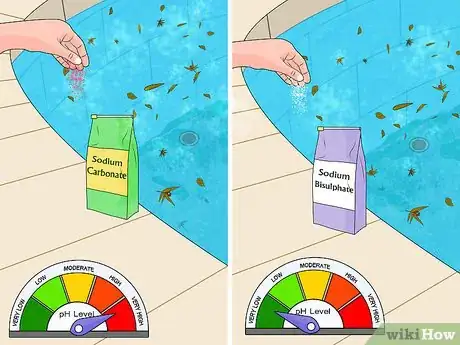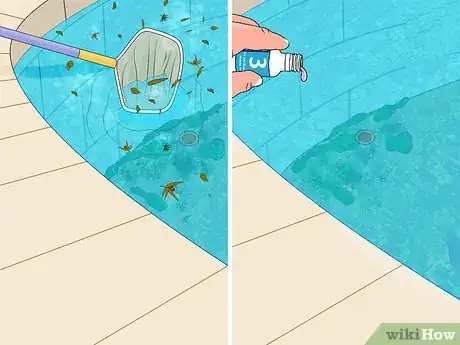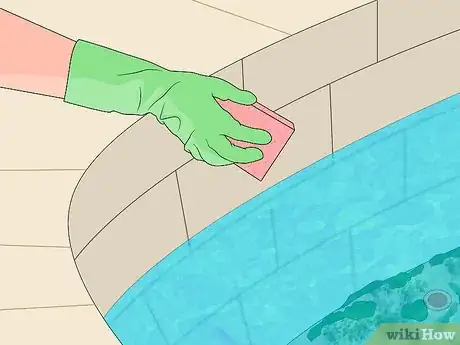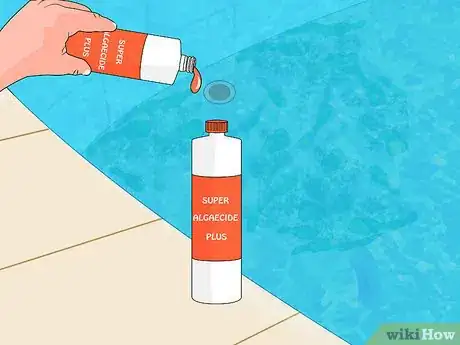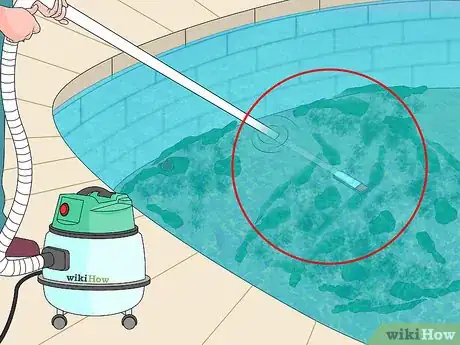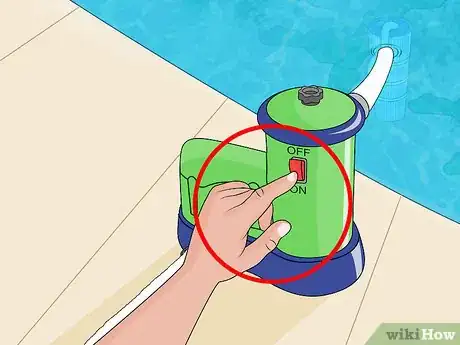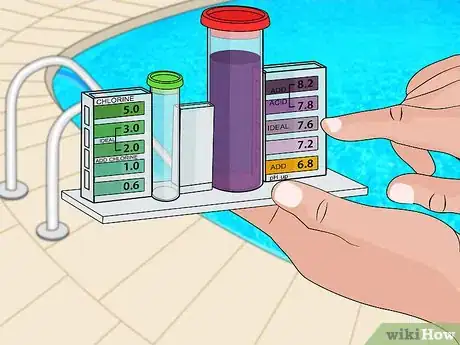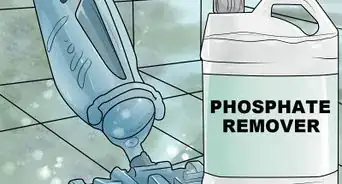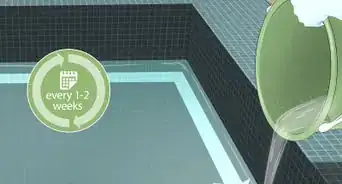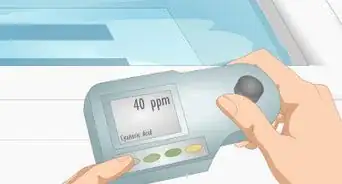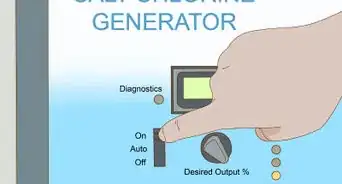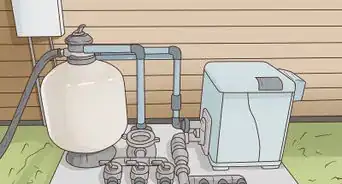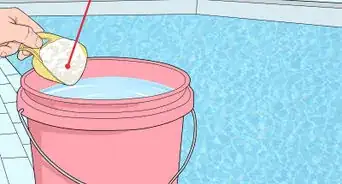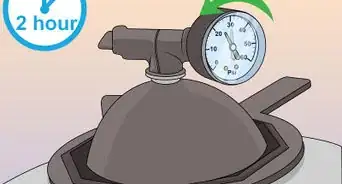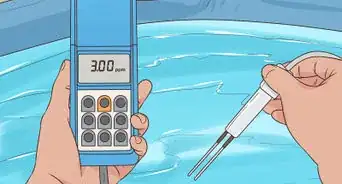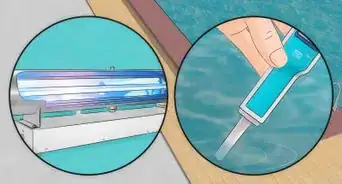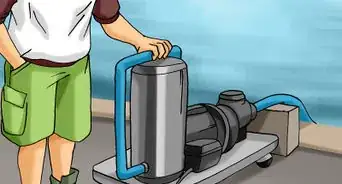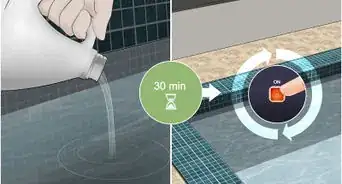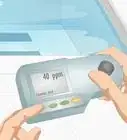This article was co-authored by Rob Litman. Rob Litman is a Landscaper, General Contractor, and the CEO of Vitoli Inc., a landscaping, hardscaping, ecoscaping, and swimming pool design company in Los Angeles, California. With over 20 years of experience in construction, Rob specializes in energy-efficient and drought-tolerant landscaping. He holds General Building Contractor (Class B) and Registered Pool/Spa Contractor Licenses. In 2007, Rob won House of the Year in Gardena, California.
There are 7 references cited in this article, which can be found at the bottom of the page.
wikiHow marks an article as reader-approved once it receives enough positive feedback. This article received 21 testimonials and 86% of readers who voted found it helpful, earning it our reader-approved status.
This article has been viewed 1,025,192 times.
It's never fun to pull back your pool cover and see that the water has turned green and swampy. That means algae has temporarily taken over, and you'll need to thoroughly clean and treat your pool before you can start swimming. Read on to learn how to get rid of the dreaded green water.
Steps
Getting Ready to Treat the Pool
-
1Test your swimming pool water. Use a chemical test kit to test the chlorine and pH levels and determine the extent of the problem. When chlorine levels drop below 1 ppm, it can cause algae to grow in the pool, turning the pool water green. When this happens it is necessary to "shock" the water with chemicals to kill the algae and return the pool to normal chlorine levels.[1]
- Proper pool maintenance, including having working filters and making sure your pool's chlorine and pH levels remain steady, can prevent algae from growing in the first place.
- Algae is constantly growing, so letting your pool sit without maintenance for even a few extra days might create a green pool water situation.
-
2Balance the pool chemistry. Before treating the pool, balance the pH by adding either an acid or a base to bring the level to just around 7.8. This is at the high end of the range you would normally want in your pool, but that's necessary when you're treating it for algae. Here's how to balance the pH:[2]
- Turn on your pump so the chemicals will circulate throughout the pool.
- Correct the pH level by either increasing the pH with sodium carbonate or decreasing it with sodium bisulfate.
Advertisement -
3Make sure the filter is working properly. Clean out any leaves, sticks, and other debris that may be clogging the filter. Backwash the filter if necessary and make sure it is working well before you add chemicals to the pool to kill the algae. Set the filter to run 24 hours per day so it filters out all the algae during the cleaning process.
-
4Scrub the sides and bottom of your swimming pool. Use your pool brush to scrub the pool well before adding any chemicals to the water. Algae clings to pool surfaces, but scrubbing will remove it. Scrubbing also helps to break the algae up, allowing chemicals to work faster.[3]
- Scrub especially well in areas where you can see algae buildup. Try to break it all up so that the pool gets thoroughly clean.
- If you have a vinyl pool, use a nylon scrub brush. Wire brushes might damage vinyl pools, but may be used on plaster pools safely.
Shocking the Pool
-
1Treat the pool with pool shock. Pool shock has high levels of chlorine that wipe out the algae and sanitize the pool. Choose a powerful shock with around 70% available chlorine, which is enough to handle tough algae and bacteria. Follow the directions on the shock package to make sure you use the proper amount for the water in your pool.[4]
- If you have a high amount of algae in your pool, you may have to treat it more than once to keep the algae from continuing to bloom.
- The water might look cloudy or dirty when you add the shock, but as the water runs through the filter it will begin to clean up.
-
2Treat the pool with algaecide when chlorine has fallen below 5.0. Allow the algaecide to work in your swimming pool for at least a 24-hour period.[5]
-
3Prevent pressure buildup in your filter by cleaning it often to remove the dead algae. When algae dies, it will fall to the pool floor or float in the pool water. It will also lose its green color.
Finishing the Job
-
1Vacuum up the dead algae left behind in your swimming pool. Use your brush to clean the bottom and sides of the pool again, then vacuum up all the dead algae. If there are a lot of dead particles and you're having trouble vacuuming them, you can add a flocculent to help the algae bind together and make it easier to vacuum.[6]
-
2Run the filter until the algae is gone. Your swimming pool water should be crystal clear after treatment. If the algae seems to be coming back, go through the shocking and treating process again until it's all cleared away.
-
3Re-check chemical levels with your swimming pool test kit. All chemical levels should be in the normal range.
Expert Q&A
-
QuestionWhy does my pool have a green tinge?
 Rob LitmanRob Litman is a Landscaper, General Contractor, and the CEO of Vitoli Inc., a landscaping, hardscaping, ecoscaping, and swimming pool design company in Los Angeles, California. With over 20 years of experience in construction, Rob specializes in energy-efficient and drought-tolerant landscaping. He holds General Building Contractor (Class B) and Registered Pool/Spa Contractor Licenses. In 2007, Rob won House of the Year in Gardena, California.
Rob LitmanRob Litman is a Landscaper, General Contractor, and the CEO of Vitoli Inc., a landscaping, hardscaping, ecoscaping, and swimming pool design company in Los Angeles, California. With over 20 years of experience in construction, Rob specializes in energy-efficient and drought-tolerant landscaping. He holds General Building Contractor (Class B) and Registered Pool/Spa Contractor Licenses. In 2007, Rob won House of the Year in Gardena, California.
Licensed Landscaper & General Contractor It might have to do with the color of your pool! If the inside of your pool is gold, your pool water might look green (since the yellow pool and the blue pool water create a green color).
It might have to do with the color of your pool! If the inside of your pool is gold, your pool water might look green (since the yellow pool and the blue pool water create a green color). -
QuestionI just filled my pool up and put my chlorine tablet in my filter. My pool water is a clear green color. What did I do wrong and how can I fix it?
 Community AnswerThere's nothing you have done wrong. I would suggest keeping your filter running 24 hours a day so that your water is continuously circulating and your filter is always catching debris. The green color in the water means that there is algae present, and the only thing that will get rid of algae is a sanitizer (chlorine). Sometimes just putting one chlorine tablet just isn't enough chlorine. This means you have to find a way to put in large amounts at once, which is referred to as "shocking" your water. I usually use liquid chlorine to sanitize my water, and then I add two tablets in a floating chlorinator so that I always have chlorine entering the pool.
Community AnswerThere's nothing you have done wrong. I would suggest keeping your filter running 24 hours a day so that your water is continuously circulating and your filter is always catching debris. The green color in the water means that there is algae present, and the only thing that will get rid of algae is a sanitizer (chlorine). Sometimes just putting one chlorine tablet just isn't enough chlorine. This means you have to find a way to put in large amounts at once, which is referred to as "shocking" your water. I usually use liquid chlorine to sanitize my water, and then I add two tablets in a floating chlorinator so that I always have chlorine entering the pool. -
QuestionMy pool has turned green and has sand in it. How do I clean it without draining it?
 Community AnswerRun your pool filter, then scrub your tile surfaces. Vacuum and shock your pool afterwards. If sand and debris are still present do a backwash.
Community AnswerRun your pool filter, then scrub your tile surfaces. Vacuum and shock your pool afterwards. If sand and debris are still present do a backwash.
Warnings
- Do not add any chemicals to your pool unless you know what you are doing. Adding the wrong chemicals will create additional problems.⧼thumbs_response⧽
- Use extreme caution when exposed to chlorine. It may cause a sore throat, a cough, or skin, eye and lung irritation.⧼thumbs_response⧽
- When mixing pool chemicals with water, use caution. Always add the chemical to the water.⧼thumbs_response⧽
- Never mix chemicals together.⧼thumbs_response⧽
Things You'll Need
- Chemical test kit
- Pool brush
- Chlorine shock
- Algaecide
- Pool vacuum
- Pool net
References
- ↑ https://www.poolcenter.com/waterTestFaq
- ↑ https://blog.intheswim.com/the-ultimate-guide-to-pool-water-balance/
- ↑ http://www.inyopools.com/HowToPage/how-to-remove-black-algae-from-your-pool.aspx
- ↑ https://www.homedepot.com/c/ah/how-to-get-rid-of-algae-in-a-pool/9ba683603be9fa5395fab90f66e6267
- ↑ https://clearcomfort.com/benefits-of-algaecides-for-your-pool/
- ↑ https://www.riverpoolsandspas.com/blog/how-to-identify-treat-and-remove-algae-in-pool
- ↑ https://www.intheswim.com/eGuides/pool-algae-guide
About This Article
To get rid of green water from a pool, start by using a chemical test kit to test the chlorine and pH levels. Then, add sodium bicarbonate to increase the pH, or sodium bisulfate to decrease it. Next, clear any floating debris, and scrub the sides and bottom of the pool with a pool brush. Afterwards, add a pool shock with 70% available chlorine, or an algaecide if the chlorine level has fallen below 5.0. Let the treatment sit for at least 24 hours, then use a pool vacuum to remove the dead algae. For more advice, including how to prevent green water by cleaning and maintaining your pool filter, keep reading.

